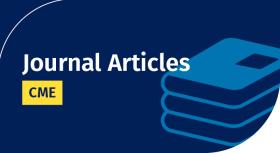
Summary for Clinicians: Clinical Practice Guideline for the Diagnosis and Detection of Sarcoidosis
The first evidence-based guideline for the diagnosis and detection of sarcoidosis was recently published by a multidisciplinary committee of experts from the American Thoracic Society. A systematic review of literature was completed by the committee to shed light on several areas of interest, including establishing initial diagnosis, lymph node sampling, and screening for and diagnosing extrapulmonary disease. The guideline has different implications for patients, clinicians, and policy makers. Clinicians should apply caution when interpreting the recommendations and should always consider unique individual clinical circumstances, including the individual values and preferences when managing patients with sarcoidosis.
Target Audience
Pulmonologists, critical care specialists, translational researchers, and clinicians
Learning Objectives
At the conclusion of this activity, learners should be able to:
- Describe the diagnostic criteria for sarcoidosis.
- Describe how to sample affected lymph nodes.
- Describe how to screen for extrapulmonary manifestations of sarcoidosis.
Accreditation Statement
The American Thoracic Society is accredited by the Accreditation Council for Continuing Medical Education to provide continuing medical education for physicians.
Disclosure Declaration
Article Authorship Disclosures (as submitted to the ATS prior to article publication date)
Arindam Singha, M.D. (The Ohio State University Wexner Medical Center, Columbus, OH, USA) reported no relevant financial relationships.
Shu-Yi Liao, M.D., M.P.H., Sc.D. (National Jewish Health, Denver, CO, USA) reported no relevant financial relationships.
Derrick D. Herman, M.D. (The Ohio State University Wexner Medical Center, Columbus, OH, USA) reported no relevant financial relationships.
Elliott D. Crouser, M.D. (The Ohio State University Wexner Medical Center, Columbus, OH, USA) reported no relevant financial relationships.
Lisa A. Maier, M.D., M.S.P.H., F.C.C.P. (National Jewish Health, Denver, CO, USA) reported receiving grants from NIH/NHLBI, Foundation for Sarcoidosis Research, University of Cinncinati under a Mallinckrodt foundation, ATYR1923-C-002, MNK14344100, and serves as a member of the FSR Scientific Advisory Board, for which she does not receive compensation.
Robert P. Baughman, M.D. (University of Cincinnati, Cincinnati, OH, USA) reported receiving grants from Gilead, Mallinckrodt, Bayer, Genentech, aTyr, Novartis, Bellephorn, Foundation for Sarcoidosis Research, and personal fees from Mallinckrodt.
Joseph K. Ruminjo, M.D. (American Thoracic Society, New York, NY, USA) reported no relevant financial relationships.
Carey C. Thomson, M.P.H., M.D. (Mount Auburn Hospital, Cambridge, MA, USA) reported no relevant financial relationships.
Off-Label Usage Disclosure
None
Disclosures of AnnalsATS CME Planners
The Annals of the American Thoracic Society (AnnalsATS) original research, commentaries, reviews, and educational content of interest to clinicians and clinical investigators in pediatric and adult pulmonary and sleep medicine and medical critical care. The scope of the journal encompasses content that is applicable to clinical practice, the formative and continuing education of clinical specialists, and the advancement of public health.
The publication of articles that meet these goals by itself is only one step in a multi-step process for the translation of evidence-based improvements in are to clinical practice. Testing for CME credit is designed to function as a next step in the process. This is accomplished through a series of questions written by the author(s) to test that readers have the tools needed to translate recommendations for diagnostic and therapeutic clinical care into clinical practice. Members of the AnnalsATS editorial board review these questions and edit these questions for clarity, educational content, and the quality of the evidence supporting the response to the question.
AnnalsATS CME Planners
Alan M. Fein, M.D.
Podcast Editor, AnnalsATS
Dr. Fein reported that he has no financial relationships with ineligible companies.
Constantine Manthous, M.D.
Associate Editor, AnnalsATS
Dr. Manthous reported that he has no financial relationships with ineligible companies.
Gregory A. Schmidt, M.D.
Editorial Board, AnnalsATS
Dr. Schmidt reported payments for writing a textbook on critical care medicine (McGraw-Hill) and for writing contributions for UptoDate.
Instructions to Receive Credit
To receive credit for this journal article:
- Read the journal article. Keep track of how long it takes you to read it.
- Once you open the article, the Post-Test becomes available. After reading the article, answer the post-test questions. You must answer all questions correctly to earn credit. You may take the test as many times as you like.
- Once you pass the Post-Test, the Evaluation becomes available. Answer all the evaluation questions.
- Once you complete the evaluation, select the amount of credit to receive based on the time it took you to read the article.
- You can view, save and print your Certificate by pressing the Certificate button.
- To review the credits you've earned in this system and reprint certificates, go to the My Learning drop-down list. Then select Transcript.
Available Credit
- 1.00 AMA PRA Category 1 Credit(s)™The American Thoracic Society designates this for a maximum of 1.00 AMA PRA Category 1 Credit(s)™. Physicians should claim only the credit commensurate with the extent of their participation in the activity.
- 1.00 Participation

 Facebook
Facebook Twitter
Twitter LinkedIn
LinkedIn Forward
Forward